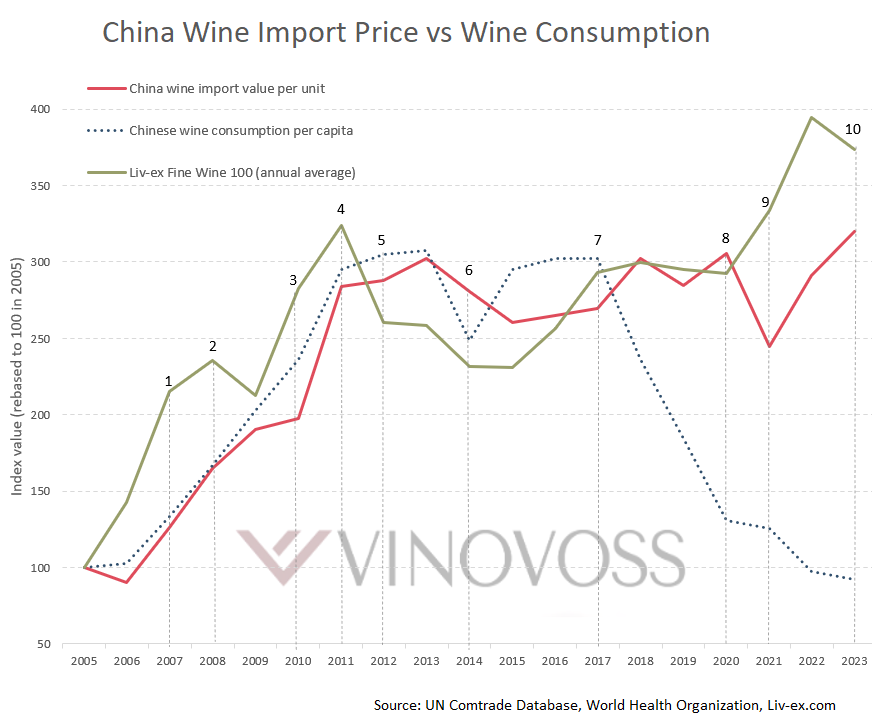- Wine Color/Type
- Top Occasions
- Unique Wines
- Surprise Me!
Navigating the Complexities of China's Declining Wine Market
The landscape of China's wine industry, once flourishing within its borders, has recently encountered a sharp decline. The economy has declined. Reduced domestic expenditure has exacerbated this trend. Furthermore, the consequences of a no longer in use Zero COVID plan have contributed to the reduction.
As domestic sales falter, the industry's stalwarts are eyeing export markets with renewed interest and ambition.
Although China's average wine consumption and overall import volume have decreased in recent years, China's wine import value per unit actually peaked in 2023, catching up with the Liv-ex Fine Wine 100 trend. (Char: Krystal Wen, Data source: UN Comtrade Database, World Health Organization, Liv-ex.com)
Timeline of key wine events:
1 - July 2007: Hong Kong reduces duty rates from 80% to 40%.
2 - March 2008: Hong Kong eliminates duty, setting it at 0%.
3 - November 2008: China unveils economic stimulus initiatives, injecting 4 trillion yuan into infrastructure, transport, industry, tax cuts, and finance. This period witnesses a rising interest in fine wine among Chinese officials.
4 - June 2010: The Bordeaux 2009 vintage is released En Primeur at historically high prices.
5 - May 2011: The Bordeaux 2010 vintage launched at record prices, challenging market resilience.
6 - July 2012: China initiates a crackdown on luxury gift-giving among government officials.
7 - July 2014: The Bordeaux 2013 vintage EP campaign was unsuccessful, showing that the market has reached a low point since before the China-led boom.
8 - December 2017: China's wine import value and volume both surpassed previous records.
9 - January 2020: China enforced a lockdown in Wuhan and other towns in Hubei in an attempt to isolate the source of COVID-19.
10 - March 2021: China formally introduces tariffs on Australian wine.
11 - August 2023: China lifted all the Covid-19-related restrictions, allowing tourists to visit the country.
The Declining Market
Kym Anderson, an Australian economist, believes that the drop in China's wine business is over a decade old, while COVID may explain part of the current downturn.
China's wine imports peaked in 2017, both in terms of value and volume. China imposed duties on Australian wine in March 2023, forcing the average wine import price per unit to fall even more. In 2023, China’s wine import dipped to USD$1.08 billion, marking a consecutive six-year decline.
As the shadows of pandemic restrictions lift, China is rekindling its relationship with the global wine community. In August 2023, China lifted all the Covid-19-related restrictions. ProWine Shanghai trade fair resumed in November 2023, marking China's return to the wine world's commercial exchanges.
Declining Wine Consumption
In China, wine consumption is mostly a social activity. Therefore the shutdown hurt wine sales more than other beverages.
According to the data above, which mirrors the wine import figures, Chinese wine consumption per capita peaked in 2017. As a result, people in the wine trade were led to believe that the Chinese market was growing quickly, but in reality, consumption per capita has been falling ever since. The consumption decreased even more dramatically following the start of the COVID shutdown in February 2020. According to the International Organisation of Vine and Wine (OIV), China's wine consumption will fall even more in 2023, hitting levels last seen in 2005.
Between 2019 and 2022, the pandemic cut Chinese wine sales by 47%, whereas spirits and beer sales fell by just 17% and 3%, respectively. If wine consumption falls as a result of the discouragement of gift-giving and the ban on extravagant official banquets. Why did the Baijiu (Chinese distilled spirits) not follow a similar declining trend?
China's wine market has recently decline due to less social activities (Photo by Bangyu Wang on Unsplash)
Ray of Optimism 1: Premiumization
The chart at the top shows that the average wine import prices did not follow the downward slope trend. Instead, China’s Wine Import Value Per Unit peaked in 2023, and saw a 9.9% YOY increase.
This might be explained by the 'premiumization tendency', which is evident in many other markets, including the United States and the United Kingdom. Consumers are simply drinking less, but better.
The fact that the Wine Import Value Per Unit line closely resembles the Liv-ex Fine Wine 100 (year average) line indicates that customers trade volume for value. They may purchase less wine, but at a higher price.
Meanwhile, despite a little dip in 2023, the Liv-ex Fine Wine 100 (annual average) is up 273.6% since 2005. Similarly, China’s Wine Import Value Per Unit had a 220.1% increase over the same period.
Ray of Optimism 2: The Booming Domestic Wine Production
According to the OIV, China has the world's third biggest vineyard area. Marselan, a French grape variety that thrives in China, might be a source of optimism. Wine experts and wine growers believe that the Marselan grape has the potential to become a popular choice for Chinese wine. This is due to its versatility and unique qualities.
Professor Demei Li showcased China's diverse wine and regions at many wine expos in Europe like ProWein and the London Wine Fair. Government measures in Ningxia are fueling worldwide recognition ambitions. The Ningxia Wine Bureau is keen to promote the province's viticulture in international contests and wine fairs. The prestigious French luxury goods company LVMH began selling the iconic Ao Yun wine in 2017.
[insert:wine:ao-yun-ao-yun-pu-tao-yuan-shangri-la-ao-yun-2019]
Conclusion
China, as a major player in the fine wine market, nudged the wine market by influencing the distribution, branding or even chateaux sales strategy.
The Chinese wine market is likely to grow as domestic incomes increase and local production improves. The premiumization trend and the export of Chinese wine contribute to this increase. The wine world will be ready.
Krystal Wen
Latest articles


